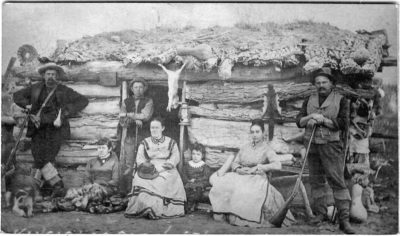Food has long been a focus of society. While our modern way of life includes regular trips to the grocery store, where there is more variety than we know what to do with, our ancestors didn’t have it quite that easy. We are literally only a few generations away from a time in which people hoarded their food, both on the westward trail and in their root cellars, just to make sure they would make it through winter.
Other than the last century or so, the need to stockpile food has been the main effort of people the world over. With harvest times coming only once a year, the size of the harvest and how well it was preserved determined whether the next year would be one of lack or plenty. When drought occurred, it would be a serious enough event to destroy villages, major cities and even entire cultures.
The Quickest And Easiest Way To Store A Month’s Worth Of Emergency Food!
Going west, a Conestoga wagon or a converted farm wagon made into a prairie schooner was mostly filled with food, as well as other necessities. While some families started out with expensive furniture in their wagons, that was soon left by the wayside, lightening the load, so they could keep their all-important food. A typical load of food would consist of the following for each adult in the family. Similar provisions for children would be brought along, with the quantities adjusted for their size.
- 200 pounds of flour (could be any type of flour, not just wheat flour)
- 30 pounds of pilot bread (otherwise known as hardtack)
- 2 pounds of saleratus (baking soda)
- 10 pounds of salt
- Half a bushel of corn meal
- Half a bushel of parched and ground corn
- 25 pounds of sugar
- 10 pounds of rice
- 75 pounds of bacon
- 5 pounds of coffee
- 2 pounds of tea
- Half a bushel of dried beans
- 1 bushel of dried fruit
- A small keg of vinegar
Once leaving Independence, Missouri, there would be little chance of resupply. That food would have to last them, augmented by whatever they could hunt and any berries they could find. While there were a few military posts with Sutler’s stores (general stores that provided the military), they were few and far between.
So, what did our ancestors do with this and what did they really eat? Well, a lot of it would seem rather normal to us, but there was also a lot that was not normal. Some things that we wouldn’t even recognize. However, it all had one thing in common: Food that the pioneers ate had to be non-perishable, as they had no way of refrigerating it.
1. Buffalo, bear, cougar and squirrel
 One of the easiest ways for pioneers to restock or stretch their food supplies was to hunt. Hunting provided them with fresh meat, something they had no chance of bringing with them. But that meant they ate whatever they could find. Crossing the Great Plains, buffalo were common, so they were eaten. When they got into the mountains of Colorado, Wyoming and points west, the buffalo were replaced by bear, cougar and deer. They would even eat squirrels, if they couldn’t find anything else.
One of the easiest ways for pioneers to restock or stretch their food supplies was to hunt. Hunting provided them with fresh meat, something they had no chance of bringing with them. But that meant they ate whatever they could find. Crossing the Great Plains, buffalo were common, so they were eaten. When they got into the mountains of Colorado, Wyoming and points west, the buffalo were replaced by bear, cougar and deer. They would even eat squirrels, if they couldn’t find anything else.
Jim Bridger, the mountain man, claimed that cougar meat was the best there was. While cougars weren’t anywhere near as common as deer, when one came along, it was often eat or be eaten. You’d better be quick with your rifle, or you just might end up as dinner.
Shooting a squirrel was difficult, as the size of the bullet would destroy much of the usable meat. They didn’t have .22 caliber rifles back then. So instead of shooting the squirrel, they’d “bark it” by shooting the bark of the tree, just beneath it. This would knock the squirrel off the tree, unconscious, saving the meat.
2. The insides of the animals, too
They couldn’t afford to let anything go to waste. So, it wasn’t unusual for pioneers to eat parts of the animal which we would turn our noses up at. Brain, heart, tongue, liver and even intestines were eaten, often cut up and put in something.
This practice is still common in much of the world today. While we don’t eat much other than the muscles of the animals, in Mexico they eat the tongue, cheek meat, heart, liver, intestines and stomach. Some of these are used for special recipes, which are considered near delicacies by the Mexicans.
3. Frying pan bread
Baking bread on the trail was nearly impossible, so instead, they made frying pan bread. This was basically biscuits, cooked in a frying pan, rather than in an oven. Biscuits and bacon were one of the staples of the trail.
While you might think that breads are breads, breads were much different back then. You might not recognize them for what they were. First of all, most flour was whole grain, not our white pastry flour. While white flour did exist, it wasn’t common, except in the larger cities.
The World’s Healthiest Survival Food — And It Stores For YEARS and YEARS!
They also didn’t have the same types of leaven that we have today. Most women “made” their own yeast, by leaving a container of “sourdough starter” open for bacteria to invade it. This would then be saved, allowing them to make bread every day.
But these breads were much heavier and heartier than the breads we know today. A loaf of bread on the frontier probably weighed two to three pounds, even though it was smaller than our common one pound loaf. But that bread stuck with you longer, providing more nutrition and calories than our modern breads do.
4. Salt pork
 While bacon was the most common preserved meat they’d eat, those in the military usually had to make do with salt pork. This is much like bacon, but without as much meat. Essentially, a piece of salt pork is a chunk of fat, with a little pork meat running through it. Soldiers would be issued salt pork as their version of combat rations, whenever they were on the move. They’d slice it and fry it, eating it with pan bread.
While bacon was the most common preserved meat they’d eat, those in the military usually had to make do with salt pork. This is much like bacon, but without as much meat. Essentially, a piece of salt pork is a chunk of fat, with a little pork meat running through it. Soldiers would be issued salt pork as their version of combat rations, whenever they were on the move. They’d slice it and fry it, eating it with pan bread.
5. Yucca root
The root of the yucca plant is something like a potato. As the southwest was settled, this became a staple for many of the people, as the land was already littered with yucca plants. Tougher than our potato, and more fibrous, it was nevertheless a good source of carbohydrates. Cut up and boiled in water, it would soften up and make a great filler for soups and stews.
6. Pine nuts
The pine cone we know so well really isn’t the seed of the pine tree, but rather the husk for that seed. Hidden deep within its many scales are pine nuts, which are the seeds. These can be removed by simply banging the pine cone upside-down on a hard surface.
Pine nuts can be eaten raw, or toasted, much like many other nuts. They have a distinct, but pleasant flavor. Like many nuts, they are an excellent source of fats, which they needed. Little of what they ate had much in the way of fats in it. Wild animals don’t grow anywhere near the amount of fat that our domesticated animals do, and they couldn’t go to the store for a bottle of cooking oil.
7. Acorn bread
Acorns, the seeds of the oak tree, are plentiful in some parts of the country. A seed, they are much like many other nuts. Gathered, they can be roasted to dry them and then ground, making flour out of it. Like the flour of any other grain, this can then be turned into bread. For some pioneers who didn’t have access to resupplies of wheat flour, acorn bread and cornbread were the only breads they had available.
What would you add to our list? Share your knowledge in the section below:
Discover The Secret To Saving Thousands At The Grocery Store. Read More Here.












